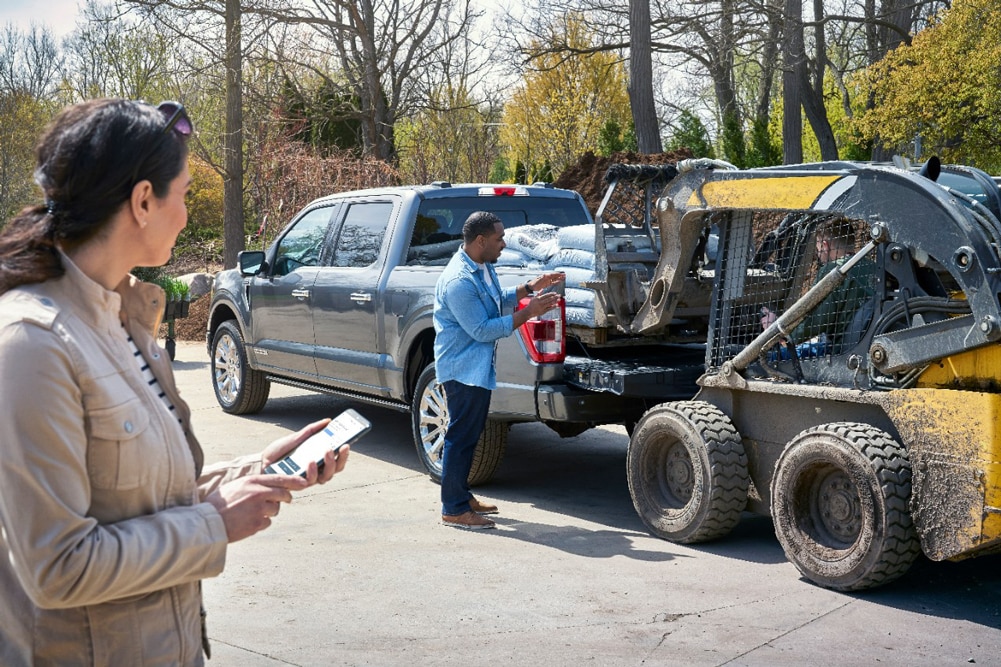What Are Ford's New Onboard Scales and Smart Hitch?
New features for the Ford F-150 pickup take the guesswork out of towing a trailer and hauling cargo.
 Ford
Ford
Pickups are engineered to excel at towing and hauling, but even full-size trucks have their limits. Dump too much gear into the cargo bed, or try to tow a trailer that's too heavy or improperly balanced, and you can quickly get into trouble. With that in mind, Ford recently introduced two new features for the F-150 full-size pickup truck that help owners determine how much weight their trucks are carrying.
Ford’s Onboard Scales and Smart Hitch use sensors to measure the squat (or compression, if you want to get technical) in the F-150’s suspension and then calculate an estimated payload or trailer tongue weight. The features are bundled together as an option on most F-150 models, standard on the Limited trim, and not available on F-150s with a regular cab and a six-and-a-half-foot bed. As an option, the package costs a reasonable $650, but it often requires other add-ons, which can push the price of the truck up by thousands of dollars. For anyone who does a lot of heavy hauling and towing, though, Onboard Scales and Smart Hitch take the guesswork out of safely transporting a load from Point A to B.
 Ford
Ford
Onboard Scales Offer Built-In Payload Estimation
Every vehicle has a gross vehicle weight rating or GVWR, which represents the maximum weight, including the weight of the vehicle, that it has been designed to handle. Determining a vehicle’s maximum payload (or cargo) capacity (which includes the weight of the driver and any passengers) is simply a function of subtracting the weight of the vehicle from the GVWR.
The math is easy, but coming up with accurate numbers to input isn’t. It’s not always possible to put your cargo on a scale, finding or measuring your vehicle’s weight is a pain, and your passengers may never speak to you again if you ask how much they weigh before they climb in. But all of these weights should be factored in for safety's sake when you’re carrying materials near the truck’s limits. As a result, a lot of hauling involves guesstimating a truck’s payload before setting off on a trip.
Ford's Onboard Scales take the uncertainty out of hauling by using those built-in suspension sensors to estimate how much payload is in the F-150. The system uses the infotainment display to show how much cargo capacity is left before you drive away. There's no need to sit in the cab while loading up, either: you can access the Onboard Scales through a Ford app on your phone or by keeping an eye on the four bars in the truck's taillights that progressively light up as you near the truck’s max payload.
 Ford
Ford
Smart Hitch Helps Balance Your Trailer’s Load
It’s possible to exceed a truck’s capabilities with a trailer that is lighter than the manufacturer’s maximum towing capacity. If the trailer's tongue weight (the force that it puts on the truck’s hitch once hooked up) is too heavy, it can push the GVWR or rear axle weight rating over the limit. Tongue weight plays a crucial role in a trailer’s stability while it's being tugged along on the highway. Typically, tongue weight needs to be between 10 and 15 percent of the trailer load to prevent the trailer from swaying, but no more than that, or you risk putting too much stress on a pickup's rear axle and tires.
Just like Onboard Scales does for payload, the Ford F-150's Smart Hitch serves up hard numbers on tongue weight. Using the same infotainment/app/taillight display options, Smart Hitch prevents drivers from overloading a hitch or driving with an unbalanced trailer. If the system suggests that the load is unsafe, a driver can rebalance the trailer by shifting the cargo towards the front or the rear of the trailer.
Smart Hitch and Onboard Scales offer a better way to measure heavy loads compared to the old ways of doing things. They are more convenient than using truck-stop scales, far more accurate than eyeballing the suspension, and far safer than never stopping to consider if a pickup is overloaded.
Written by humans.
Edited by humans.
 Benjamin Hunting
Benjamin HuntingBenjamin Hunting is a writer and podcast host who contributes to a number of newspapers, automotive magazines, and online publications. More than a decade into his career, he enjoys keeping the shiny side up during track days and always has one too many classic vehicle projects partially disassembled in his garage at any given time. Remember, if it's not leaking, it's probably empty.
Related articles
View more related articles